If you want good food in Italy, follow the wine. Good food follows good wine as the night the day. If an area has an articulated wine route, that’s even better. And if it has three separate wine routes, you can practically order from a menu with your eyes closed. So it’s easy to see why Brescia is one of four Italian cities to be honored jointly as the “European Region of Gastronomy 2017. ” Brescia lies in the heart of the famed wine-producing area called Franciacorta, which stars a champenoise-style sparkling wine with classic double fermentation, also referred to as Franciacorta. The area claims 2,800 vineyards and produces four million bottles yearly. Half of these come from the area’s largest producer, Berlucchi, whose cantina can be visited upon request. And the local restaurants pride themselves by serving traditional Brescia food.

Brescia at night By Pedritosway – Template:Andrea Bonassi,
The other three honored cities for 2017 are Bergamo, Cremona, and Mantua. All are located in East Lombardy and share overlapping culinary traditions, given similarities in their topography, agriculture, and animal husbandry. Brescia is the largest of the four, and arguably the most varied geographically, with mountains and plains, lakes and hills, farmers and fishermen, and three wine distinct wine trails. Its rich table reflects all these influences. Of 22 Michelin-starred restaurants in East Lombardy, half (11) are found in and around Brescia.
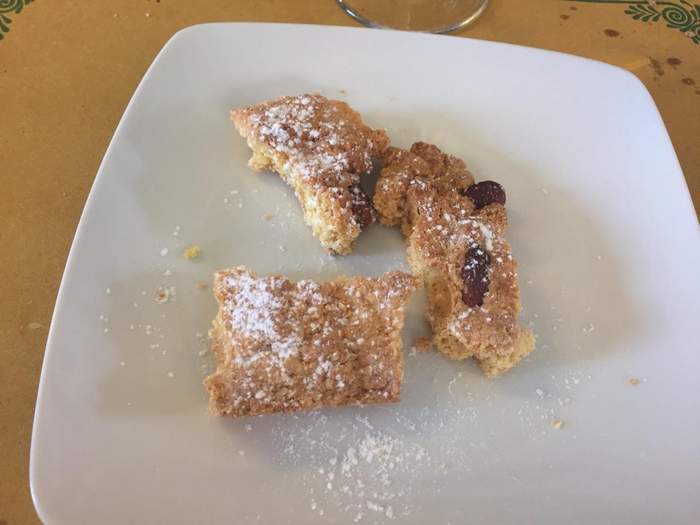
Sbrisolona, a crumbly sweet with almonds and butter, is popular all over East Lombardy.
Respect for regional heritage is ever-present, but creativity is a driving force in Italian kitchens today. So on a recent trip to taste Brescia food I was able to sample local classics both time-tested and unexpected. Our first meal was at La Vineria, in the oldest building on Piazza della Loggia, the city’s 15th century plaza. Our hosts cautioned that ours would be a “light lunch’, to ease us into the weekend’s gluttony. But one person’s light lunch is another person’s overload. We began with trays of locally-produced coppa and “Salame Morenico di Pozzolengo DOP”. Coppa is short for capocollo (capo means “head” and collo means “neck”). It looks and tastes something like prosciutto but is not brined. It was served with local honey and red onion coulis. The salame’s DOP designation comes from the specific process by which it is made, as well as its natural ingredients.

Local salumi and cheeses at La Vineria, punctuated by local honey and onion coulis.
Separate cheese plates featured local products. The better-known Bagòss is from the Sabbia Valley; this is a semi-hard cheese aged a minimum of 12 months (but can age up to three years) made with saffron for subtlety of flavor. Fatulì (the name is dialect for “small piece”) is a goat cheese made from a particular breed of goat found in this area. Its production is being encouraged by Slow Food.
Our second course was a choice between linguine and casoncelli. The linguine were flavored with butter, almonds, and dried sardines from nearby Lago Iseo. The casoncelli, a variant of ravioli, were stuffed with ground meat and dressed with butter and sage. Dessert was sbrisolona, a sweet cake (more Mantovano than Bresciano) that is broken into pieces rather than sliced. It is made with flour, almonds, butter, and eggs, and can taste sweeter, drier, crunchier, more crumbly, depending on the baker.

Linguine with almonds and dried sardines at La Vineria, wonderful Brescia food.
The evening meal was at Senorvino, a wine shop cum bistro in the heart of town. Our hosts selected it as an example of food trends in Brescia and not only: it is one in a 16-shop franchise in northern Italy. The young and energized staff cater to an equally young and svelte clientele, with more than 1,500 Italian wine proposals on offer. You sit at wooden tables surrounded by walls of wine, to which your knowledgeable waiter serves as guide.

A wall of wine at Senorvino in Brescia
And yes, there is Brescia food for snacks, appetizers, or a full meal, a standard menu supplemented by local specialties. The latter included casoncelli with Bagòss cheese, borragine, a local green cooked like spinach, and risotto alla Franciacorta, with the eponymous wine and Vialone Nano rice, a variety cultivated in Mantua. Salads were sparkling fresh, platters of salumi e formaggi (salami and cheese) were generous, and desserts were curious spins on classics, such as a tiramisu that came as a foamy cream with cocoa sprinkled around and a soggy Savoyard on top.
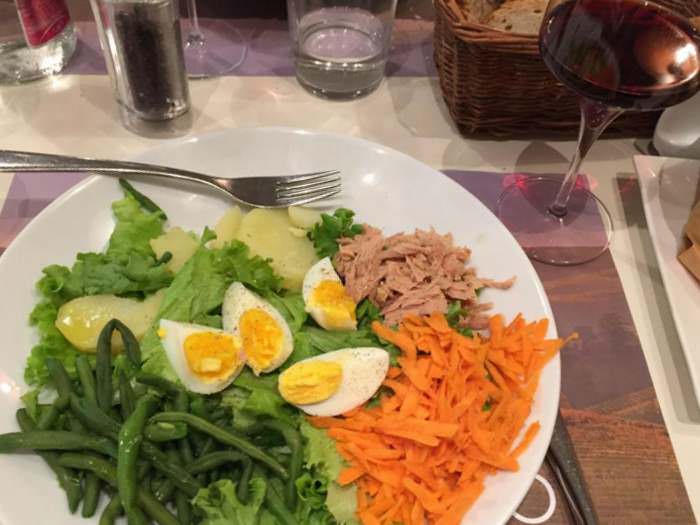
Simple salad executed with flair at Senorvino.
Our next day’s lunch was at Osteria al Bianchi, a trattoria in operation since 1880. It is applauded by Slow Food purists and casual diners alike, and the efficient waiters are well-rounded – good advertising for their edibles. No fancy décor or new wave dishes here; the emphasis is on local products honestly made and generously served. We had malfatti, a pasta of spinach, ricotta, Gran Padano cheese, eggs, and flour. It was lighter than it sounds, if too salty. The homemade pappardelle came with a smattering of porcini; they were perfect. Other local Brescia food dishes include pestöm (a combination of chopped veal and pork), snails, and bertagnì, a fried baccalà (dried cod) served as an appetizer on Saturdays only.
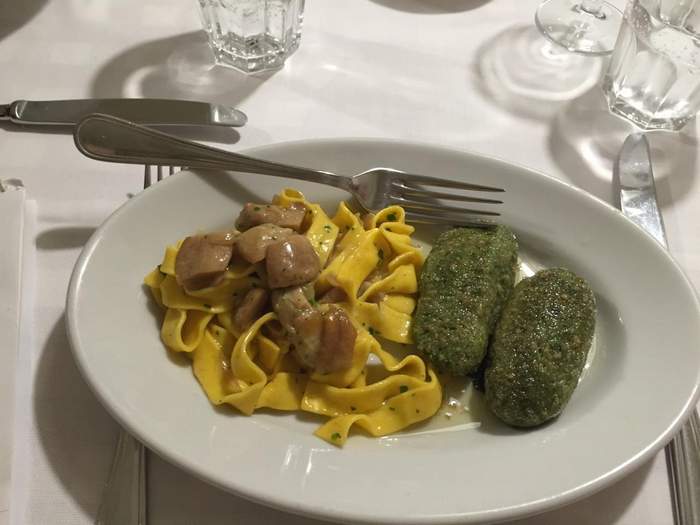
A bis of pappardelle and malfatti at Osteria al Bianchi. Hard to decide which was better.
The greatest attraction of Trattoria al Fontanone, where we had dinner that night, is its position. In the warm season, the restaurant sets out tables facing the Capitolino Temple so you can dine while absorbing the changing colors of those splendid ruins. The menu is “tradition revisited”, including local salumi and cheeses, gnocchi alla zucca con Bagòss (gnocchi with pumpkin and Bagòss cheese), and an excellent manzo all’olio (beef braised in local olive oil). Traditions from other parts of Italy are also honored, such as melanzane alla parmigiana and caponata siciliana, two southern eggplant dishes. The bread basket included homemade taralli, a specialty of Puglia. The service was grudging, and the restaurant interior paled in comparison to the outside setting.
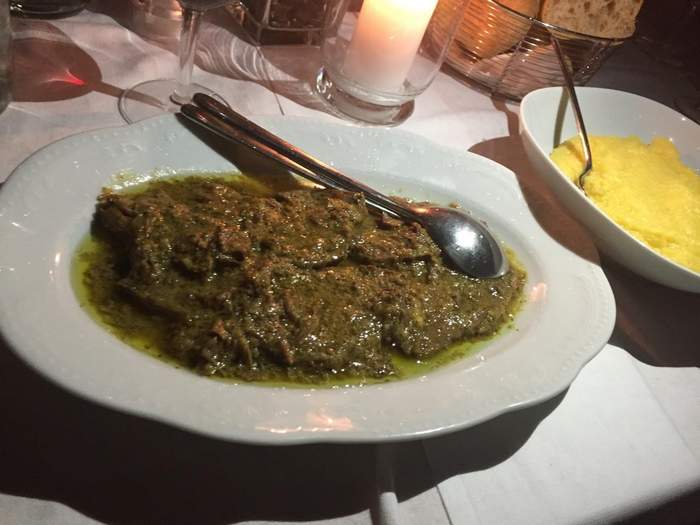
A glistening serving of manzo all’olio at Trattoria al Fontanone.
Our final meal of the trip was lunch at La Dispensa Pani e Vini, situated in suburban Torbiato, amid the hills and vineyards of Franciacorta. Wine enthusiasts opened it in 2008 to highlight the best of the wine region’s food and drink. The structure was purpose-built as wine store, bistro, and restaurant all together, so it can cater to large groups as well as individuals.
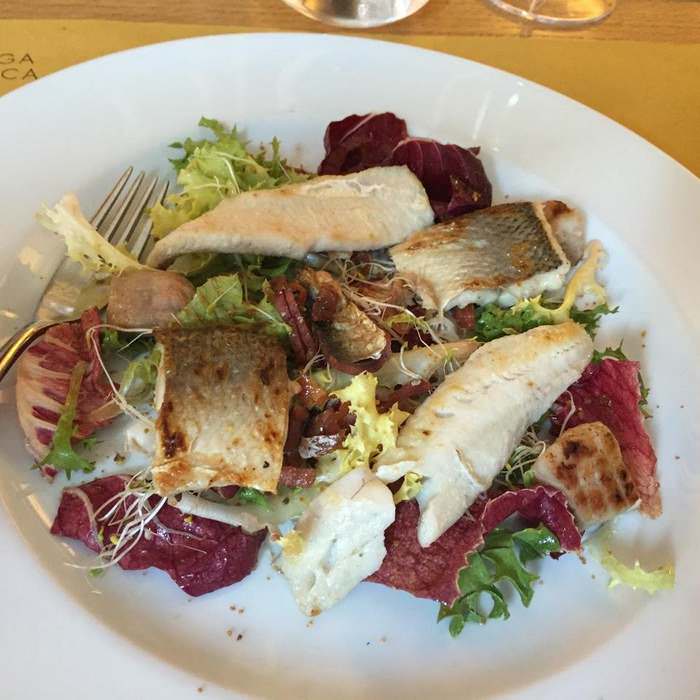
insalata di pesci del lago d’Iseo at La Dispensa Pani e Vini.
Our meal began with passato al pomodoro, a Tuscan tomato soup, and continued with farfalle al ragout di salame fresco (butterflies dressed with fresh salame). This was savory and not too salty. An insalata di pesci del lago d’Iseo (salad with Lake Iseo fish) was our second, an unassertive sequel to the farfalle. No one had room for the huge cup of tiramisu, but everyone toasted the weekend’s delights with our umpteenth glass of Franciacorta.
